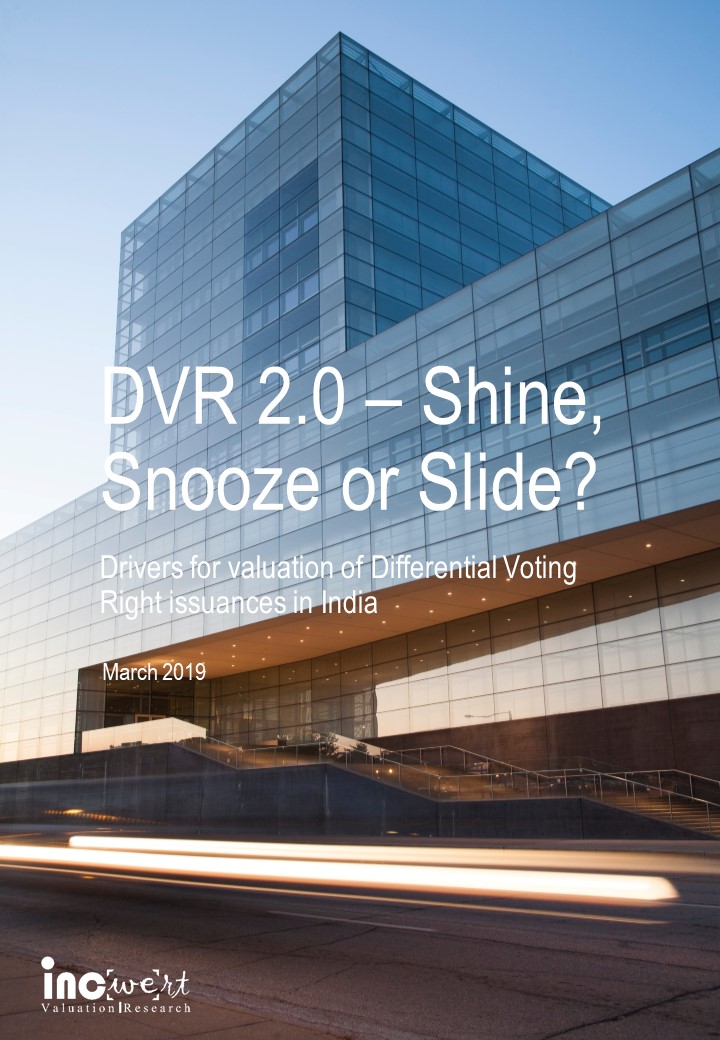Authored by: Punit Khandelwal & Sunit Khandelwal
Key Takeaway
- SEBI is reviewing the provisions for DVR shares listing possibly to create a more accommodative ecosystem for unicorns which are increasingly looking to unlock value via IPO.
- A similar liberal move has already been taken by other popular APAC stock exchanges like Singapore and Hong Kong Stock Exchange in 2018.
- DVRs are very popular in the US with more than 25% of total IPOs having DVR structures as of 2018 versus only three DVRs which trade in Indian markets as of March 2019.
- Valuation matters at two levels – first, while comparing such companies versus its peers as well as intra-capital comparison of DVR shares versus its own common stock counterpart.
- Once the market starts getting comfortable around the protection of minority’s rights, governance, reporting becomes more transparent and the company’s periodic financial performance consistently meets management and street expectations, then the discount on the DVR tends to reduce.
- Volumes need to pick-up via awareness and general market maturity; higher volumes would potentially translate in reducing the discount.
Meaning of DVRs
- Dual Class Shares (DCS) or shares with Differential Voting Right (DVR) as popularly known in India, simply means that a company has issued more than one class of stocks with different voting rights. Against a simple common stock issuance which has 1:1 voting rights (i.e. 1 vote for 1 stock owned), such equity shares have differential voting rights. For example, a company X could issue two classes of shares – Class A with voting rights and Class B with no voting rights. In another example, a company Y could issue two classes of shares – class A with 10:1 voting rights and class B with 1:1 voting rights.
- DVR structures are most commonly seen in founder-led companies where founders are considered to be critical for the success of the company, have a high amount of pre IPO funding and are averse to any change of control (1).
History & Recent Trends
- Started in the US - Dual-class shares aren’t something that has come to the world now; it had got conceptualised in the U.S. way back in the 1800s but hit the limelight in the last two decades when many technology companies like Facebook (NASDAQ: FB) where its founder, Mark Zuckerberg, has 10:1 voting rights and Google’s parent company, Alphabet Inc (NASDAQ: GOOGL for class A and NASDAQ: GOOG for class C) went for IPO. DCS listings in the US as % of total US IPOs have increased from around 2% in the early 80s to +25% by 2018(1). In comparison, India is nowhere near with just three companies having listed DVR shares.
- APAC finally tags along - There was a reluctance to list DCS IPOs by the stock exchanges in the APAC region for a long time driven by the rigidity to the principle of one vote for one share. However, in 2018, both Singapore and Hong Kong, amended their listing rules to allow DVR listing; possibly to create a more conducive environment for startups to unlock value and not miss the ship of listing multi-billion dollar IPOs! Recall, Alibaba (NYSE: BABA) had first gone to Hong Kong stock exchange but after it was denied a dual share listed, it went to NYSE. The exchange might have noted that it is the need of the hour and it changed its listing requirements. Recently, the Hong Kong stock exchange got its first DCS listing from Xiaomi Corporation (HKG: 1810).
- At a systematic level, the following parameters can be evaluated to gauge the preparedness of a market for DVR listings:
- Deeper and broader professional investor base
- Not dominated by dynastic and large family holdings in companies
- Better protection of minority shareholders’ rights and
- Strong litigious culture
- Indian context – Currently there are three listed companies which have DVR shares: Tata Motors Limited (NSE: TATAMOTORS for ordinary stock & TATAMTRDVR for its DVR), Jain Irrigation Systems Limited (NSE: JISLJALEQS for ordinary stock and JISLDVREQS for its DVR) and Future Enterprises Limited (NSE: FEL for ordinary stock and FELDVR for its DVR). Gujarat NRE Coke was the fourth company but the trading got suspended in February 2018 when it went to The National Company Law Tribunal (NCLT), a quasi-judicial body in India that adjudicates issues relating to Indian companies, for liquidation proceedings. Tata Motors was the first company to come up with DVR in 2008. At present, companies are only allowed to issue shares with inferior voting rights but superior voting rights are still not allowed.
- In mid-2018, SEBI set up a panel to review the listing rules for DVRs for facilitating listings of Indian start-ups. Considering that there are lots of unicorn startups with huge pre IPO funding and multi-billion dollar valuations assigned to them, DVRs might just provide the supportive ecosystem for the founders to unlock value through IPO and still maintain control over decision making. However, this would require the establishment of very good governance and reporting framework.
Valuation
- While looking at companies with DVR, the relative valuation would be relevant and would matter at two levels:
- DVR company versus its peers (who do not have such DVR structures),
- Intra Cap Structure – i.e., Inferior voting right share’s valuation in comparison to its own common equity with superior voting rights.
1/2 DVR issuing company versus its peers (who do not have such DVR structures)
- Should DVR companies trade at a premium or discount to its non-DVR peers? The answer is not straight forward and would depend upon a lot of factors which requires deeper analysis. But as starters, let’s ask a simple question – why did we agree for differentiated voting rights? We agreed because we believed that the founders knew the formula to beat the benchmark more than the majority shareholders. Hence, we gave them the benefit of doubt to loosen on governance and tag along with their vision and trust their decision to generate better shareholder wealth. Hence, in principle, a DCS should trade at a premium versus its peers if it is able to:
- Deliver superior financial performance versus its peers – better revenue growth, higher margin, and higher cash flows.
- Maintain its governance and not engage in anything that breaks the trust of its shareholders.
- As a corollary, if over a period of time, either one or both of the above factors start showing cracks, the premium can quickly disappear and convert into a discount. From a valuation perspective, it’s important to know the relativity of the above two factors versus peers as well as its time elapsed since its IPO and then have a view on the fair value.
- CFA Institute’s publication on DCS in 2018 proves the above hypothesis. In its publication, it cited data compiled from MSCI, as per which the Unequal Voting Right basket in Sep 2017 was trading at a P/E of 22.9x versus 20.5x for the general index driven by better growth projections in EPS and higher ROE. (1)
2/2 Intra Cap Structure – i.e., Inferior voting right share’s valuation in comparison to its own common equity with superior voting rights
- Intuitively we know the answer – DVRs would trade at a discount to its superior counterpart but the question is how much is reasonable? Again, there is no straight forward answer as the discounts vary across the globe. In a publication, CFA Institute cited such discounts range between 3% to 10.5% in the United States, 7% to 20% in Canada, 12% in Sweden, 19% in the United Kingdom, and 82% in Italy. (1)
- In India, DVR shares are trading in a range of 3% to 45% discount (6 months average) to its 1:1 common stock class as at 08-March-2019.
Factors driving the level of discount in DVR value
Following factors should be considered in making an empirical model for ascertaining the level of discount:
- Is the financial performance dwindling versus management guidance or peers in a similar industry? If yes, the discount could get deeper with this delta increasing. Albeit, in a liquidity situation the prices will tend to converge.
- Is shareholder agreement tight or lose versus industry and sector standards – for example, a sunset provision for the superior rights to fade off could have a positive impact of lower discount.
- Quality of governance and reporting – If the Company is not reporting as per industry standards, the discount could be deeper.
- % promoter holdings – higher promoter shareholdings could be a signal for a higher discount.
- Time expired since IPO and financial performance delivery – If significant time (say more than 3-5 years) has passed since the IPO and there is no meaningful financial performance delivery versus benchmark returns, then the discount could be deeper.
Overall, if companies are meeting industry benchmarks in terms of the above factors, then higher volumes in DVRs should materially narrow down the discount. Hence, assuming everything else being equal, higher volumes through investor awareness should narrow down the discount in the DVRs. In the graph below, we have presented a summary of discounts on DVR observed across various countries.
Closing thoughts
- There is no magic formula to have a benchmark number for premium or discount at which DVR companies should trade. The investor should create a matrix of KPIs for financial performance, governance, term sheet clauses (like sunset provision), general market maturity and compare against similar markets and companies in the global context to have a view on the fair value of a DVR listing.
- Increase in investor awareness would help them understand that despite no voting rights or inferior voting rights, as the case may be, there is no reduction in their “economic right”. Moreover, in a liquidation scenario, DVRs have pari passu rights with other equity common stockholders having superior voting rights without any kind of subordination. Once this is widely understood and accepted, volumes will gradually pick-up and reduce the discounts

